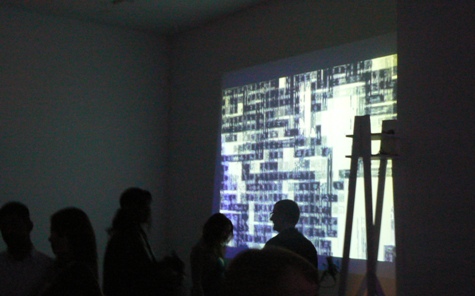As a kid, my sisters and I dubbed the malaise that comes on gloomy, somber Sundays a “Sunday Feeling.” It’s an awful feeling, brought on then by the threat of Monday and school, and made worse, by the quiet tone of the day when we all holed up to do homework, procrastinated projects, or nap late into the day, waking up to early winter dark and New England cold. Wretched and hopeless feeling. Inert.
Sunday Feelings still occur, though they’re not spurred on by the same melancholic ingredients as when I was a kid. Today, Sunday, I found myself in quite the funk, though I felt the feeling coming on last night on the way home from a gallery opening that was wholly underwhelming. Dissatisfaction in what I saw last night followed me around like a little black rain cloud all day, and more than once I glazed over, looked out the window, and sighed: “What the fuck’s the point?”
The point of what? Not sure. Everything maybe. But I spent the better part of today trying to undo the most blah mood-as-induced-by-art that I’ve had in a while. I’ll attribute it to the fact that I was eager to see the show at Centraltrak and that I was disappointed.
Disappointed that good ideas can be poorly executed? Yes.
Bored? Absolutely.
Centraltrak just mounted a show curated by John Pomara and Dean Terry called Glitch, featuring work that explores the malfunctions of digital media and what the terrain of those accidents looks like. The gallery is full of monitors and cords (lots of them) and projected images of moving pixilation, gradient color fields, or figures that blend and jump around the screen trippily. Headphones hooked to audio at each piece almost always coughed out scratchy, pulled-cord dying computer squelches, like emphysemic robots. I’m not sure what was captured malfunction in these pieces (actual computer errors), or manufactured malfunction (artist made errors). Maybe that was the point? [Shrug]
The whole show felt like it would have been compelling maybe ten years ago, maybe twelve, but certainly, whatever the premise of the show, seizure inducing computer images of scan codes, avatars and swirly digipainting just aren’t visually fresh. Even a complete non-techie like me is dulled to digital vocabularies like the ones used here: trippy, hallucinatory, color-washed screens recall screen savers c. ’97. And anyway, my brain was completely fried after the third set of headphones spewed out unimaginative, digital-jabberwocky hiccups. Can’t sick computers speak more than one language?
I left the gallery feeling how you can after a blockbuster Impressionism show full of pictures we’ve seen so often we can’t see them anymore: in a stupor, hankering for something to wake me up.
I headed to 500X looking for the antidote in a small show called Imprints: Three Generations of 500X, with work by Tom Orr, Vance Wingate, and Natalie Macellaio. It helped a little to see Tom Orr’s 1978 piece called Fatboy, his submission to the first show ever held in at 500X. It’s a white mesh readymade crimped with a repeating diamond shape that casts shadows, and for all its simplicity, plays more visual tricks than all the corded gadgetry down the road in Glitch.





